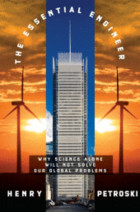The Essential Engineer: Why Science Alone Will Not Solve Our Global Problems
Science is by its very nature global. In fact, it is galactic, even universal. This is because science deals with universal laws, like the law of gravity. No matter where on earth I jump, gravity will pull me down according to the single law of universal gravitation. And no matter where an apple falls, it falls toward the ground. We believe that it has always been so, regardless of culture.
But this is not to say that practicing science is independent of culture. It is proper to speak of American science, as distinct from, say, Japanese science. Indeed, at least one Japanese scientist has taken note of the fact that his culture has yielded a paucity of Nobel laureates. This has been attributed to the deference that the Japanese culture expects of the young toward the elderly. Prize-winning scientific breakthroughs often depend on rebellion against the prevailing paradigm, not deference to it.
At the same time, the Japanese excel in technological endeavors. Their automobiles and consumer electronics are admired and bought around the world. The disciplined Japanese culture is well suited to the mass manufacturing of excellently engineered and highly reliable products. Those products that are exported fit nicely into the target culture; those that are for home consumption are distinctly Japanese.
So there appears to be a significant difference between science and engineering and how they relate to culture. A commonly cited difference between the two endeavors is that science seeks to understand what is, whereas engineering seeks to create what never was. It is wrong to describe engineering as mere applied science. There is some extra-scientific component to engineering, something often referred to as the creative or artistic component. The engineer designing a bridge does not deduce its form from scientific laws and mathematical equations. Rather, like a poem or a painting, the bridge is formed first in the engineer’s mind’s eye. It is only then that the hypothesized structure can be given a scientific or mathematical litmus test. In engineering, analysis follows synthesis–not the other way around.
It is essential that the similarities and differences between science and engineering be kept in mind when identifying and attacking global problems. Scientists and engineers come from different technical cultures as surely as Americans and Japanese do from different social ones

